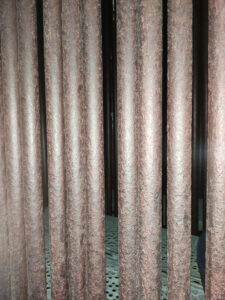OXIDE SCALE MEASUREMENT

The very high temperatures found inside steam boilers (500°C to 800°C) can cause the formation of a specific type of hard, brittle iron oxide called magnetite layer which occur on the inside and outside surfaces of steel boiler tubing. At very high temperatures, water vapor will react with the iron in the steel to form magnetite and hydrogen according to the formula: 3 Fe + 4 H 20 = Fe 3O 4 + 4 H 2
The speed of this reaction increases with temperature. Oxygen atoms will diffuse inward through the magnetite layer, and iron atoms will diffuse outward, so the scale continues to grow even after the tube surface is completely covered.
Magnetite scale acts as thermal insulation on the pipe, since the thermal conductivity of scale is only about 5% that of steel. When heat can no longer transfer efficiently from the flame through the tube into the steam inside, the tube wall will heat up to temperatures beyond the intended operating range. Long-term exposure to high temperatures, combined with the very high pressure inside the tube, leads to intergranular micro-cracking in the metal and to creep deformation (a slow swelling or bulging of the metal), which, in turn, eventually leads to tube failure by bursting. A secondary issue is oxide exfoliation, in which pieces of oxide scale break off (usually due to thermal stresses during boiler startup or shutdown). These hard pieces will be carried by the steam flow into the turbine, where, over time, they will cause erosion damage.
The growth of magnetite scale and the associated metal damage are primary limiting factors with respect to boiler tube service life. The process begins slowly and then accelerates; as the scale grows thicker, the tube wall becomes hotter and that, in turn, increases the rate of scale growth and metal damage. Studies in the power generation industry have indicated that the effect of scale is relatively insignificant up to thicknesses of approximately 0.012 in. or 0.3 mm, but that beyond that thickness the negative effects of scale increase rapidly. Periodic measurement of scale thickness enables a plant operator to estimate remaining tube service life and to identify and replace tubes that are approaching the failure point. Ultrasonic testing provides a quick and nondestructive method for measuring scale.
- Can detect both surface and near-surface indications
- Can inspect irregularly-shaped parts
- Pre-cleaning of the asset to be inspected is less essential than in other inspection methods, as existing contaminants should not affect flaw detection
- Quick to be employed and lower cost than other NDT methods
- Real-time results, as indications are visible directly on the material’s surface
- Portable inspection method makes it ideal for field inspection services
Our Other Services
- Rebound Hammer
- Ultrasonic Pulse Velocity
- Half Cell Potentials
- Concrete Core
- Carbonation
- Cover Meter Survey
- Pile Integrity Test
- Pile Dynamic Test
- Bridge Load Test
- Slab Load Test
- Cross Hole Sonic Test
- In-Situ Metallography (Replica)
- Portable Hardness Test (Rebound & UCI Method)
- Expert Metallurgy Consultant For Site
- Pressure Vessel Inspection & Maintenance
- Condition Assessment
- Remaining Life Assessment
- Fitness For Service
- Pipeline Inspection & Maintenance
- Tank Inspection & Maintenance
- IBR/Non IBR Fabrication
- Structural Health Assessment / Structure Audit
- Reactor Inspection As Per Factory Act





